Walking and Drawing
This resource shares my process of making drawings whilst walking. I wanted to develop a way of drawing that captured my sensory and visual experiences as I moved through the landscape.
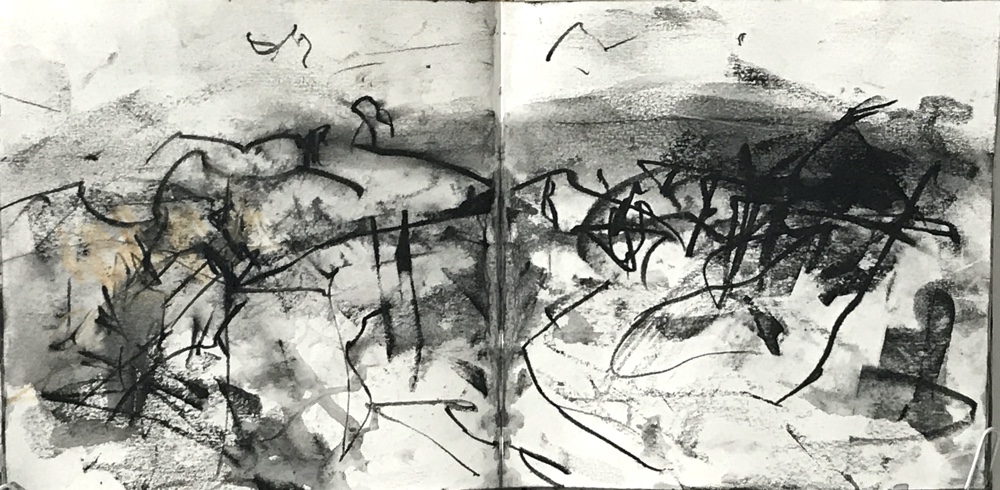
The discovery of Liza Dimbleby’s drawings were a first step in creating my own walking/drawing practice. In her book ‘I Live Here Now‘ she describes how after a relocation to Moscow, she made drawings of all that she encountered as she walked through the streets to familiarise herself with the new city. I was also inspired by the artist John Virtue, who takes a regular weekly walk of some miles, along the same route filling sketchbooks with his calligraphic mark making.
I’d been exploring the idea of sensory drawings and also drawing moving objects but I wanted to find a way to integrate my drawing and walking; to register through drawing the sensation of how I experienced the landscape when I walked, as opposed to making an observed drawing from a fixed point of view. This project also developed from my ‘drawing in the dark’ drawings, and continued my personal search to expand my visual language and knowledge of process within my drawing practice.
Looking at how other artists tackle a creative problem is always valuable and researching the drawing practice of Sophie Cunningham Dawe offered a way in to the walking drawing process. She describes her walking drawings as ‘Lines made whilst walking, just whatever catches my eye, walking quickly to give a contingent, gestural quality’.
I had never attempted to draw whilst I was moving and it felt a daunting task. The initial attempts were very challenging drawing sessions. What became immediately apparent as I began walking and drawing at the same time was that I had to make split second decisions about what I wanted to register on the page when I was already moving past the object as I looked at it. The first walks were mostly about wondering what I wanted to draw as I walked, along with the question ‘how do I draw it?’ as it disappeared out of view. Initially, the main objective was simply to put a response – any sort of response – on the page and to get comfortable with the kinetic challenge of carrying a sketchbook, a handful of pencils, making a mark and at the same time, walking safely through a space in a particular direction. In the beginning, I stopped numerous times to reflect on what I had on the page and see how I wanted to develop or alter my approach or to regularly pick up dropped pencils.
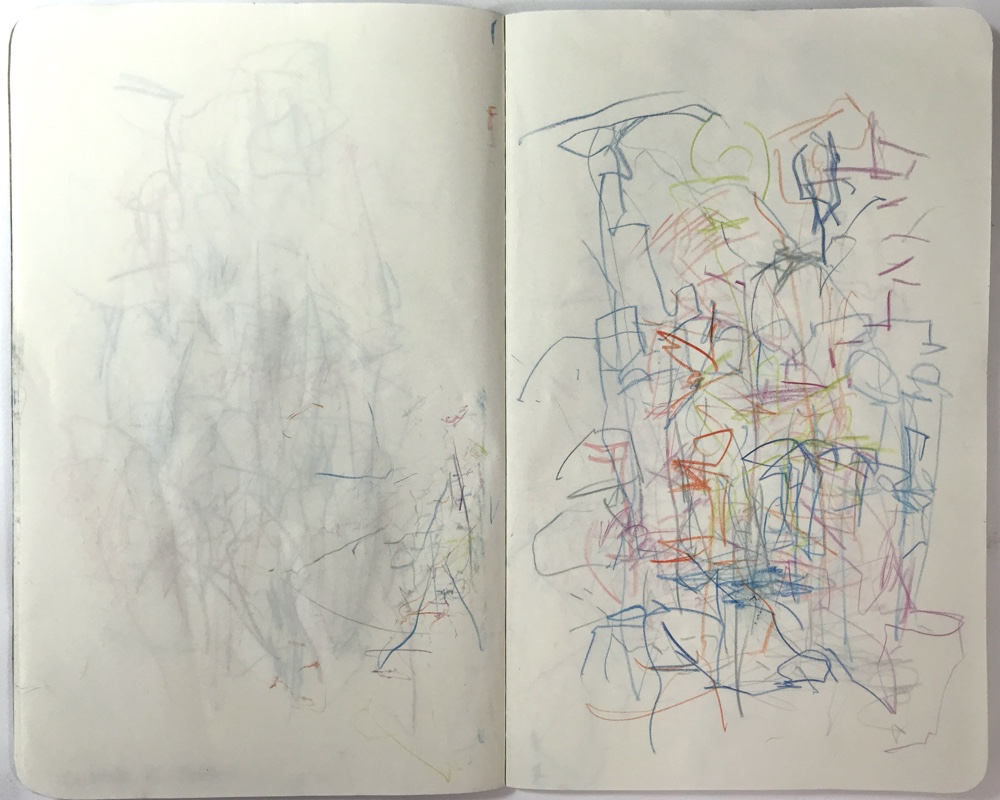
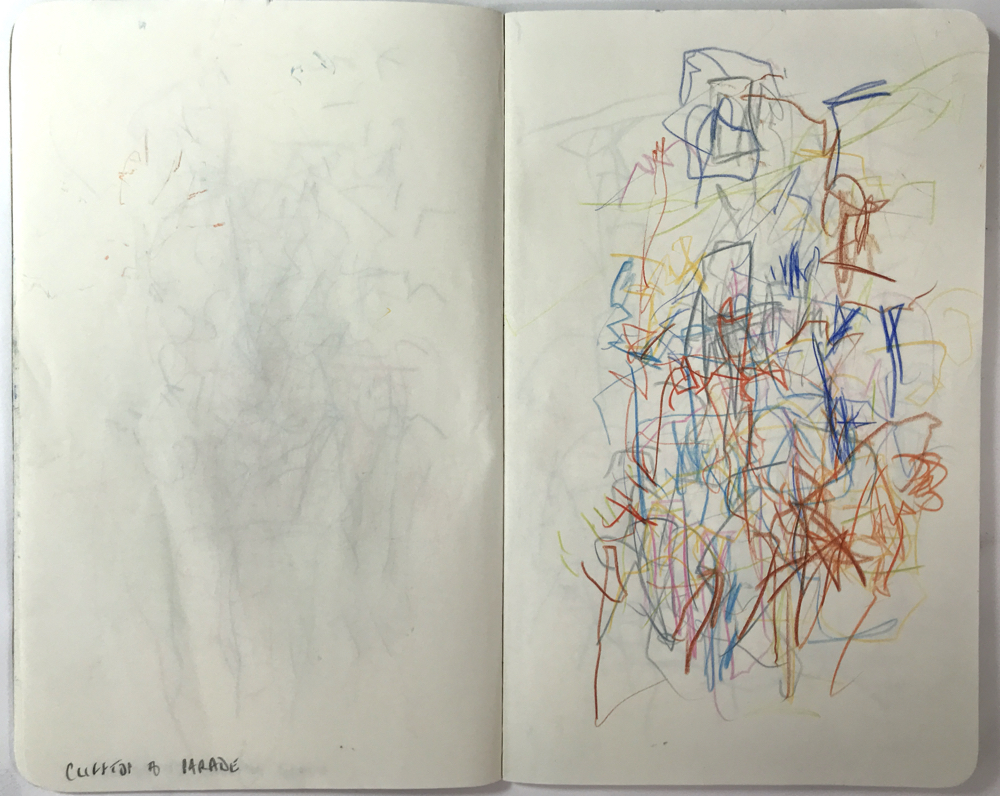
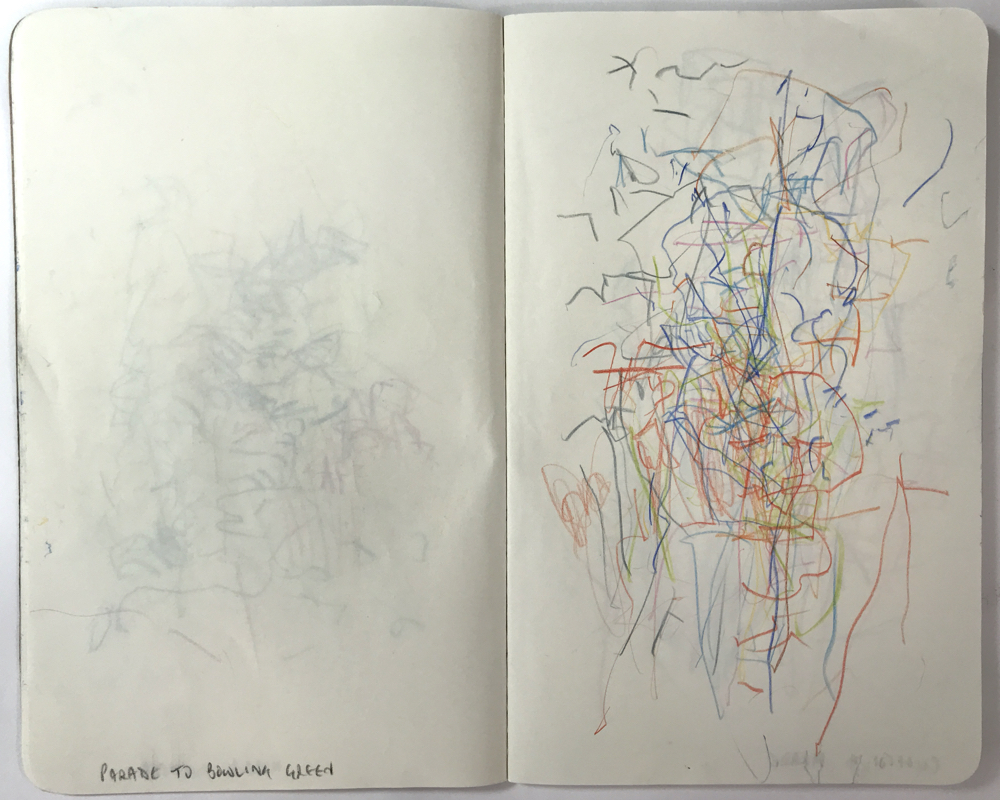
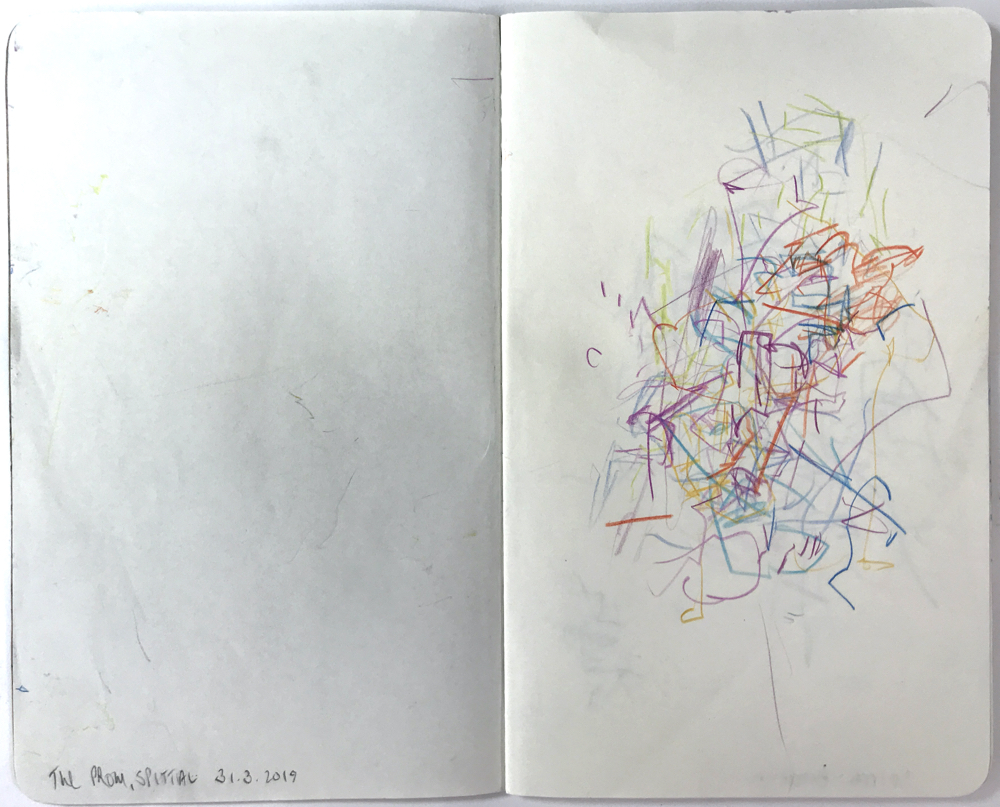
Very often when I walk, my thoughts are elsewhere but walking and drawing made me mindfully aware, moment to moment of where I was, and the position of my body in that space: my spatial relationship to the tree I was passing; the bird flying high over my head; the sea ahead of me in the distance. My surroundings felt very real and full of energy – the landscape and the space on the page felt powerfully connected and kept me very much in the present moment.
As my confidence grew, I drew more purposefully and learned to make quick judgements, processing sensory and visual information at speed into marks and lines. Because I kept my eyes on the world, essential for safety and avoidance of oncoming objects (small wayward dogs a particular hazard), I couldn’t look at my paper as I drew, so the drawings were blind drawings with the occasional quick glance down at the drawing to see what was happening. I found I was more comfortable with drawing not resting my hand on the sketchbook so that more free and expressive marks came from my shoulder and also captured the drawing gestures of my body as I moved (e.g walking over a rough track that unbalanced me might be transcribed in a juddering mark).
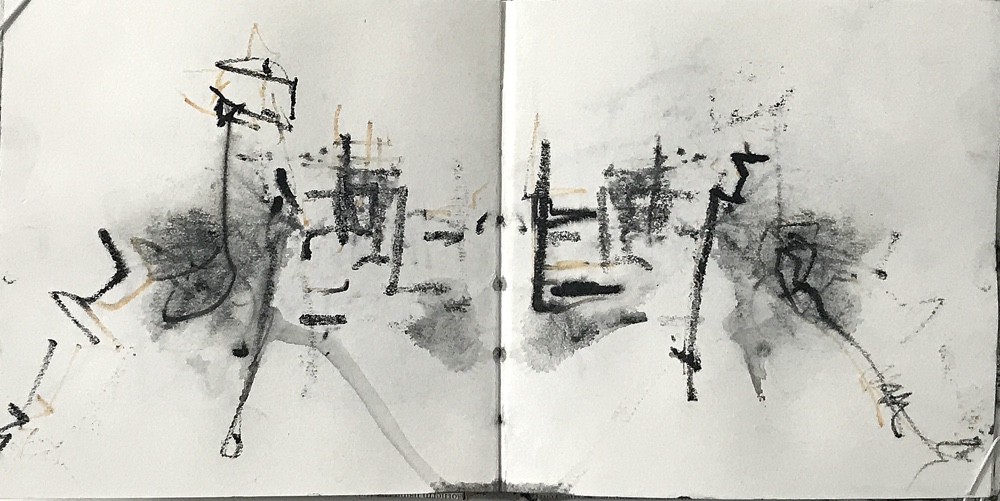
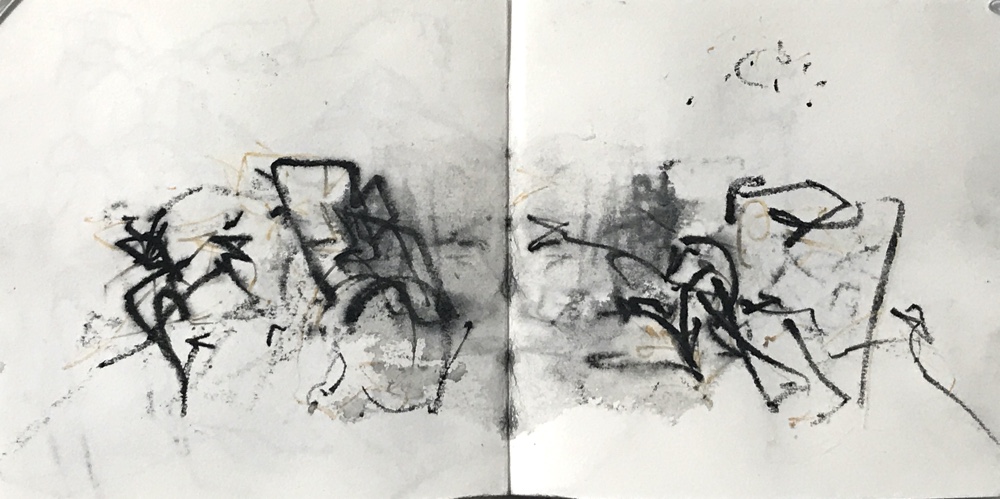
I began to draw during a regular walk to the cliff top near my home, usually at the end of the day as it moved towards dusk. The coloured pencils I’d been using didn’t capture that sense of gathering twilight and I switched to black artgraf (a solid block of ink), as I was keen to explore its expressive qualities. Its water soluble nature encouraged me to take more risks with the drawings and I combined it with a carbon pencil to achieve a variety of line and tone; occasionally I would add in a water soluble coloured pencil. I also changed the orientation of the paper switching from an A5 portrait to a small square sketchbook as this seemed to offer space to capture a broader view more suited to the open countryside I was walking in.
I made marks for the many things I was seeing and experiencing: the direction of the path; a clump of grasses moving in the breeze; the flight of birds; the line of a building; the edge of the sea; a person walking past; a bird call. Periodically, I would stop and assess my page, deciding that I didn’t want to add any more information and begin a new drawing.
To relinquish some control over the process, to open myself up to what might emerge if I added an element of chance into the drawing, I began to spray the page randomly with water to see what would happen to the media as I drew. The water changed the art graf from a firm, waxy mark to a soft, black wash with delicate frayed edges and the Woolf carbon pencil became gorgeously black when used over the damp surface – exciting discoveries! I also began to spray water onto the page in later stages of the drawings to see what effects would come from the dry marks reacting to the water.
Introducing the element of water also connected the drawings more closely with the sea and weather. The pages weren’t always dry when I turned them to begin a new drawing but I accepted this as part of the process and the blurring and spread of the media seemed to capture the insubstantial quality of objects at dusk and replicate the feeling of rain/wind during the walks.
My walking drawings are a record of a sensory and visual experience; how I view the world as I move through the landscape, drawing myself through a space. They are evidence of my lived experience moment to moment, the layering of marks recording the movement of my body when walking and the constant scanning of my vision as it alternates between a broad and narrow focus on all that I encounter. It makes me appreciate and be present in my environment and enables me to create a more ‘true’ account of how it feels for me to be in a particular place.
You can see another AccessArt resource on walking, looking and sketching at the same time here: ‘Walking Sketchbooks’

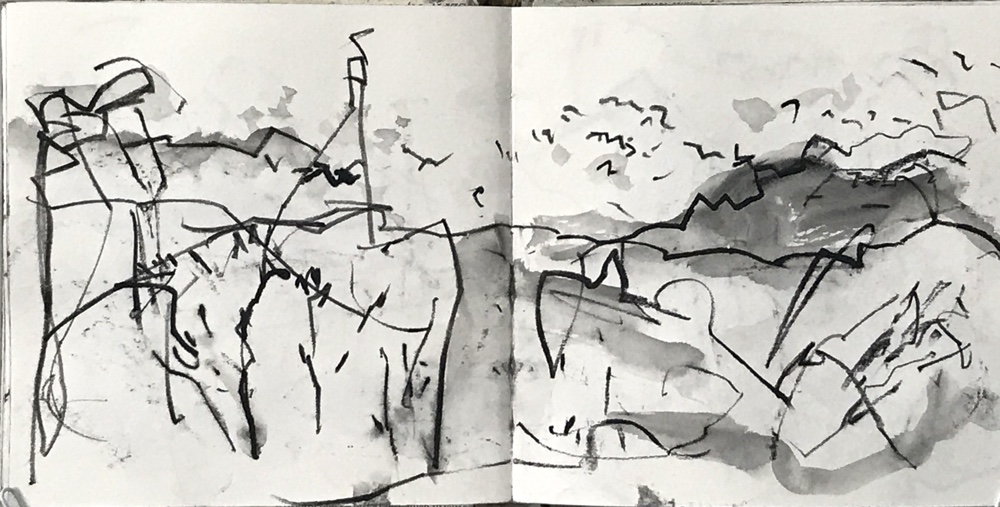
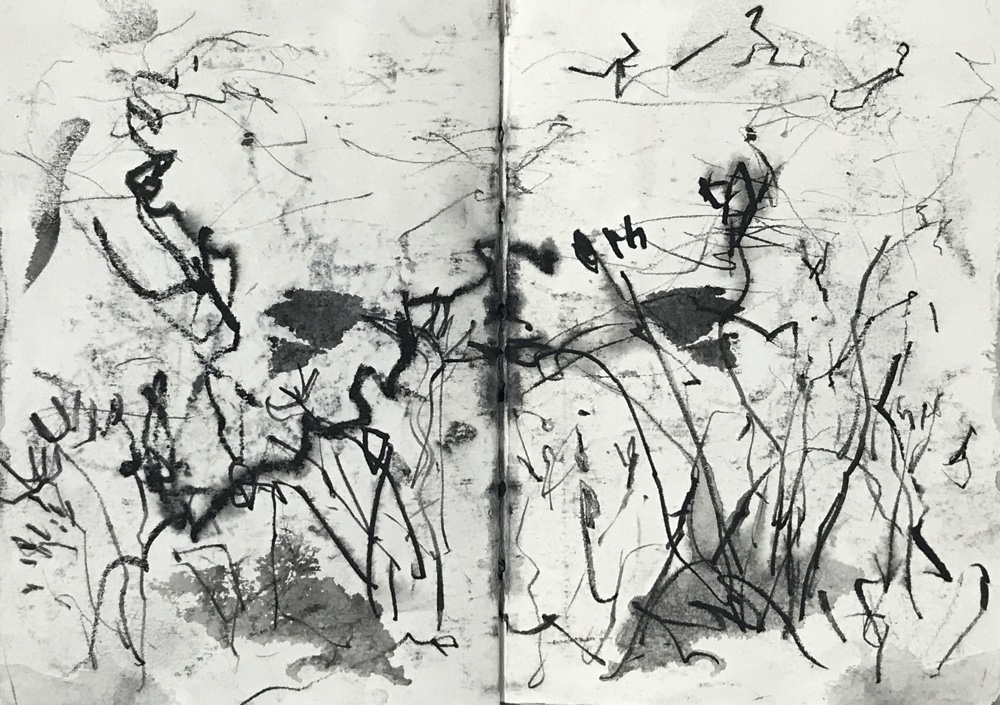
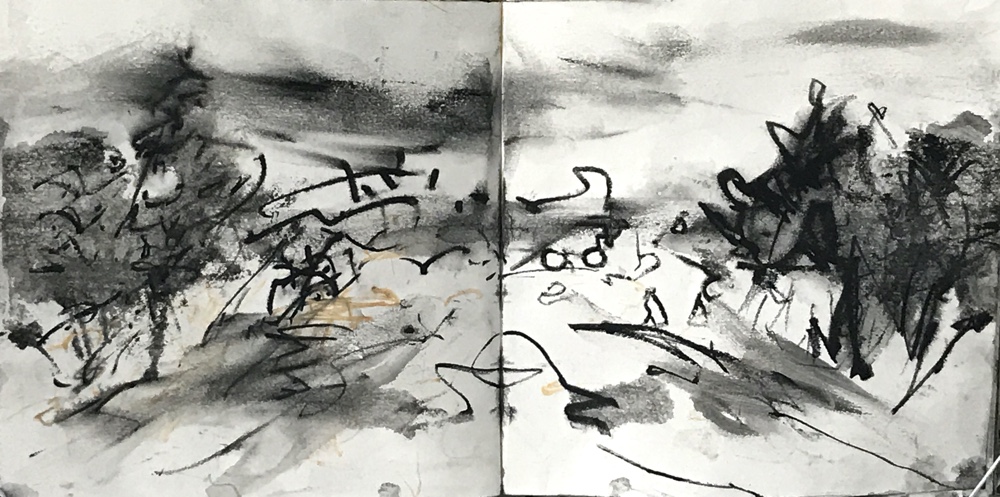
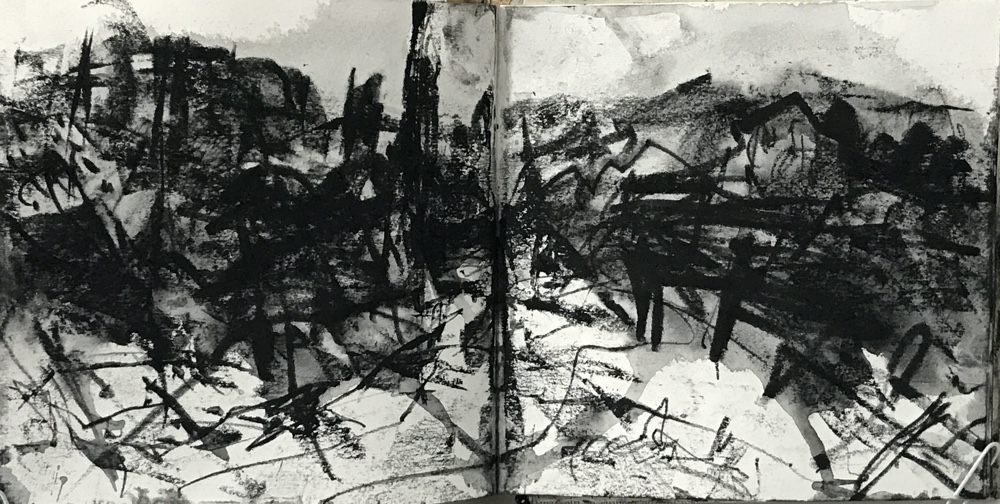
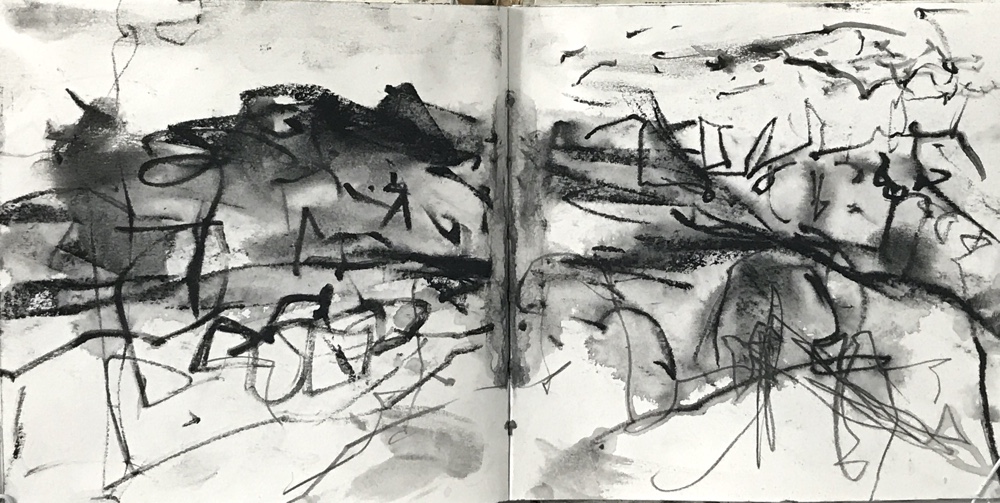
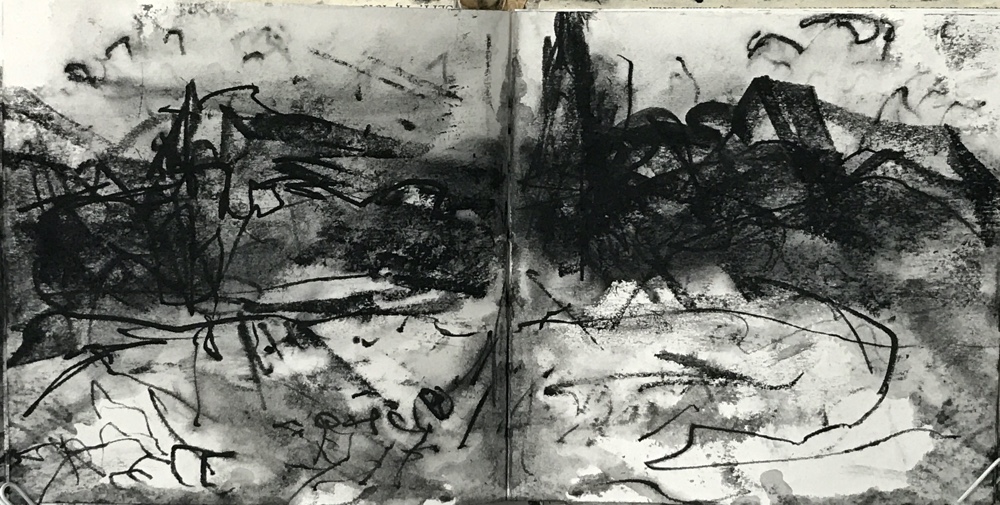
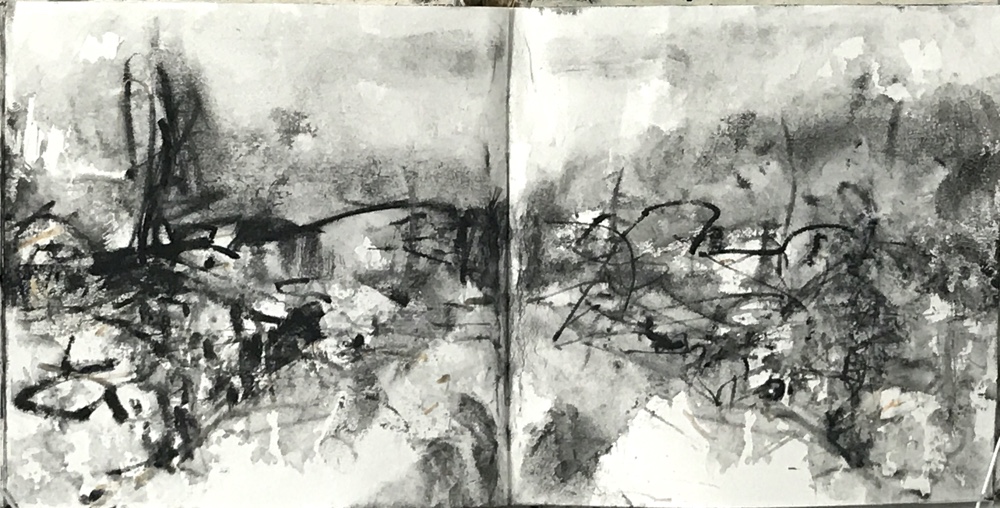
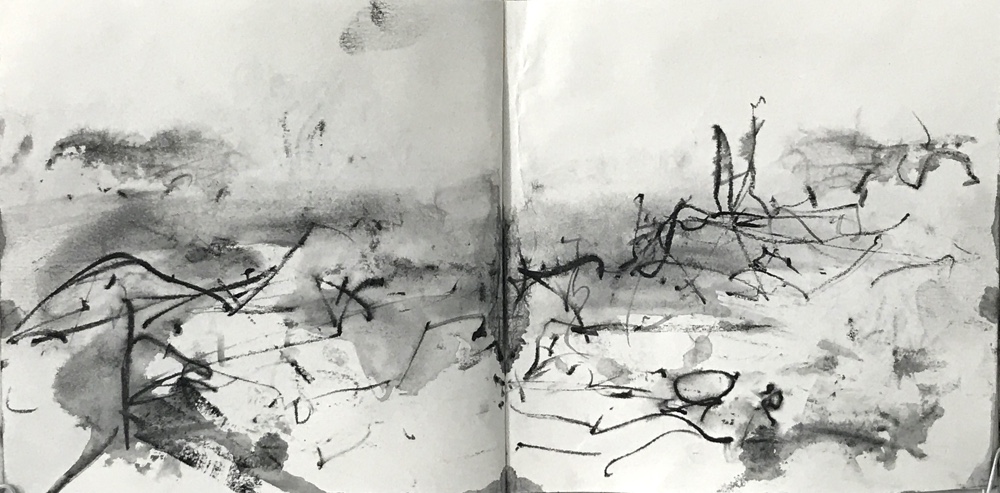
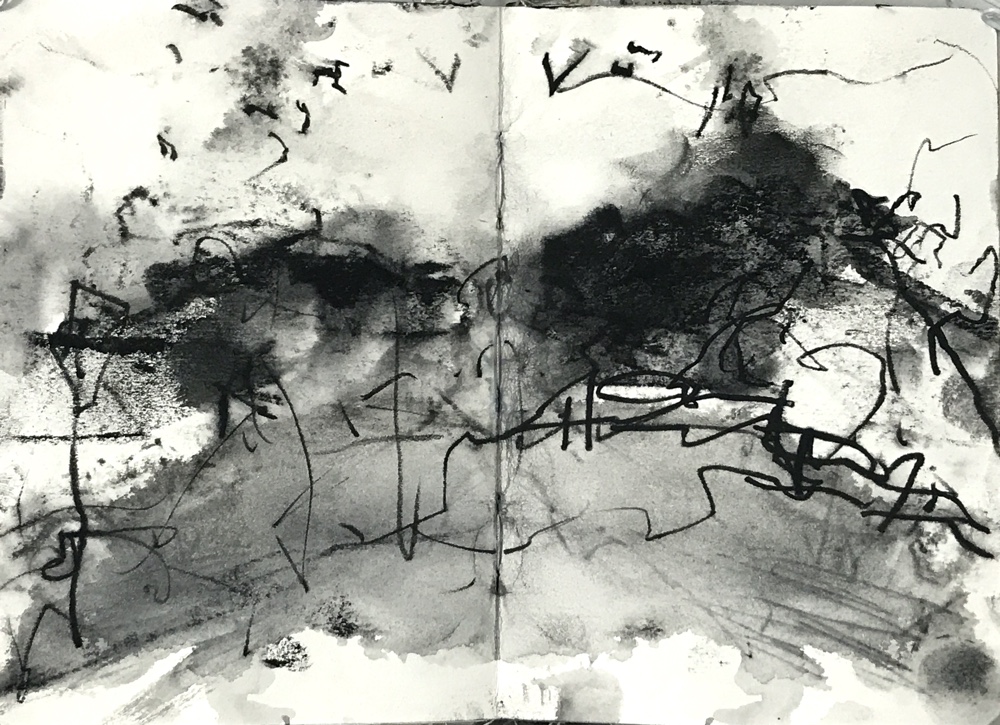
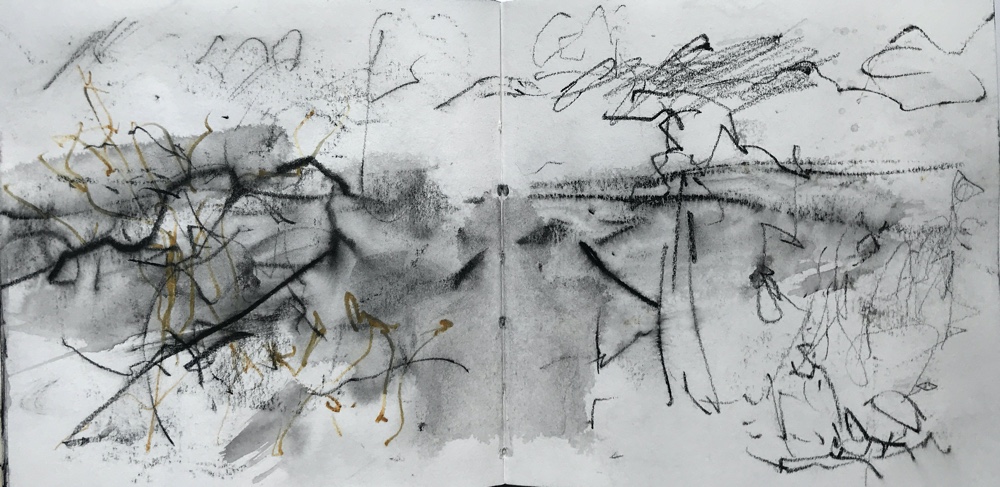
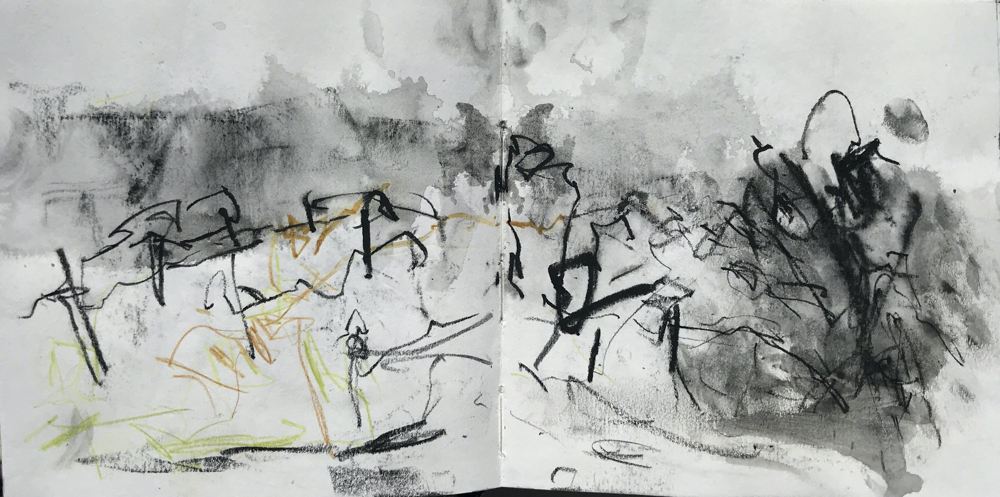
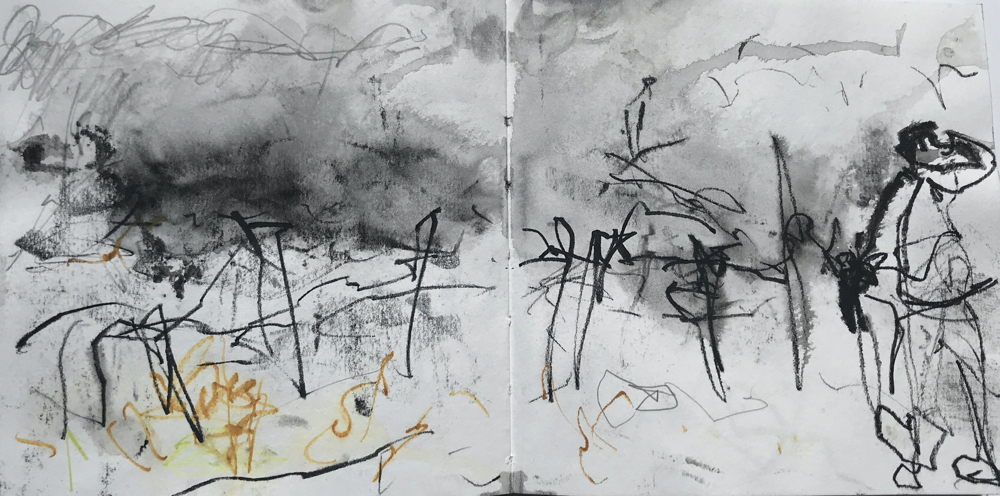
Cathy mills
September 24, 2020 @ 5:20 pm
Hi Andrea
Thankyou I so enjoyed reading your thoughts about drawing and walking , it’s inspired me to immerse myself too as I move house into an urban environment as a way to understand and find my place in a new neighbourhood..
I loved your sketches and the energy they transmit, also it was good to see my good friend Liza Dimbleby in there too!
Thanks
Andrea Butler, AccessArt
September 28, 2020 @ 4:34 pm
Thank you Cathy that’s lovely of you to say. It’s wonderful that you feel inspired to set out on your own walking drawing journey and it sounds the perfect way to become familiar with your new surroundings. It was fascinating reading about Liza’s practice and I’m very grateful to her for her descriptions of her drawing process. Good luck and I hope you settle in well to your new home!
Huw Adamson
January 10, 2021 @ 12:52 am
I’ve just stumbled across this doing research for my art degree. I love the drawings you are making, you really nail a abstracted sense of environment!
Andrea
January 12, 2021 @ 9:50 am
Hello Huw, thanks so much for your kind comments about the drawings, I do appreciate it and hopefully they also offered inspiration for your own creative process. If walking drawing is something that particularly interests you #walkingdrawing on Instagram might be of interest. Best Wishes Andrea
Frances D
September 22, 2021 @ 10:18 am
This is a fantastic resource. It reminds me (a little) of the work I did with children during the ABE (Art and the Built Environment) project back in the 90s when we experimented with drawing strategies used by architectural students to develop their understanding of drawing within an open space. There were many activities which used more controlling factors than you describe, such as making a drawing of a distant object, walking a set number of paces forward and repeating until you are very close. There were also some great ideas for developing symbolic sensory walk prompt cards which were shuffled and ‘drawn’ during a walk. E.g. an ear -draw what you hear. Thank-you so much for this super resource, it has prompted me to try it out and also to dig out some of old ideas to try for myself and maybe post the results.
Andrea
October 8, 2021 @ 2:53 pm
Thank you for your wonderful comments about my walking drawing resource and it’s lovely that you’re inspired to try the process out.I was very interested to hear about the more controlled way of drawing you’d explored through the ABE project and I loved the idea of symbolic, sensory walk prompt cards – I might make some of my own!
It’d be great to see any drawings that you make prompted by the resource and if you would like to contribute your own post discussing the ABE drawing processes and the prompt cards, then please let us know. You can find our contributor guidelines here:https://www.accessart.org.uk/be-a-resource-contributor/
Thanks again for your positive feedback and good luck with your drawings!
Carol Cumming
September 25, 2022 @ 5:17 pm
Thank you for sharing & explaining your sketchbook work, methods & creativity. Just starting out and appreciate your generosity and this website.
Andrea
September 28, 2022 @ 2:44 pm
Thanks Carol, it’s good to know that you’re enjoying the resources on AccessArt. Best wishes Andrea
howard y
July 12, 2023 @ 10:03 pm
This is brilliant !!!